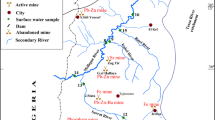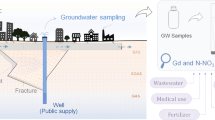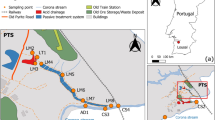Abstract
At a test site consisting of a storage pond and connected artificial aquifer, the long-time behaviour of gadopentetic acid (Gd-DTPA) was compared with the classic tracer bromide (Br–) in a 70-day dual-tracer experiment. The mixed tracer solution was injected into the oligotrophic pond, which is separated from the aquifer by an infiltration bank. The water drained from the aquifer was returned to the pond together with additional fresh groundwater, causing reduced concentrations of Gd-DTPA and Br– in the system. Transmetallation of Gd-DTPA by rare earth elements and yttrium was negligible but Cu2+ and Ni2+ might have played a role. Adsorption and/or biodegradation of Gd-DTPA were negligible. The decline of Gd-DTPA/Br ratios by 18% in the pond over 68 days was caused by reversible sorption of Br– in the aquifer, which caused variation of Br– background. Thus, Br– behaves less conservatively than Gd-DTPA in the aquifer. Comparison of both proves the suitability of Gd-chelates as tracers in hydrological studies. The advantage of Gd-DTPA as a tracer is that natural Gd3+ in water can continuously be monitored by analysing the suite of naturally occurring rare-earth elements. Thus, stable organic Gd-chelates are determinable with high precision at very low concentrations.
Résumé
Sur un site test constitué d’un bassin de rétention connecté à un aquifère artificiel, le comportement long terme de l’acide gadopentetic (Gd-DTPA) a été comparé avec le traceur classique Brome (Br-) au cours d’une expérience traçage double de 70 jours.
On a injecté les traceurs dans le bassin oligotrophe, séparé de l’aquifère par une berge perméable. L’eau drainée de l’aquifère était retournée dans le bassin avec un de l’eau douce additionnelle, causant une réduction de la concentration de Gd-DTPA et Br- dans le système. La substitution de GD-DTPA par des terres rares et yttrium était négligeable mais Cu2+ et Ni2+ peuvent avoir joué un rôle. L’adsorption et/ou la biodegradation de Gd-DTPA étaient négligeables. Le déclin des rations Gd-DTPA/Br jusqu’à 18% dans le bassin en 68 jours a été causée par l’adsorption réversible de Br- par l’aquifère, qui a provoqué une variation du fond Br-. Ainsi, Br- se comporte moins conservativement que Gd-DTPA dans l’aquifère. La comparaison des deux montre que les chélates de Gd sont des traceurs appropriés aux études hydrogéologiques. L’avantage de Gd-DTPA en tant que traceur est que le GD3+ peut être contrôlé de façon continue en analysant le cortège des terres rares naturellement présentes dans l’eau. Ainsi, les chélates organiques stables de Gd sont analysables avec haute précision à des concentrations très basses.
Resumen
En un sitio de prueba que consistió en una laguna de almacenamiento y un acuífero artificial conectado, se comparó el comportamiento a largo plazo del ácido gadopentético (Gd-DTPA) con el trazador clásico bromuro (Br-) en un experimento de trazador doble durante 70 días. La solución mixta de trazador se inyecta en la laguna oligotrófica, la cual está separada del acuífero por un banco de infiltración. El agua drenada desde el acuífero fue devuelta a la laguna conjuntamente con agua dulce subterránea adicional, reduciendo las concentraciones de Gd-DTPA y de Br– en el sistema. La transmetalación de Gd-DTPA por elementos de tierras raras e ytrio fue despreciable, pero Cu2+ y Ni2+ podría haber jugado un papel importante. La adsorción y/o biodegradación del Gd-DTPA fueron despreciables. La reducción de las relaciones Gd-DTPA/Br en un 18% en la laguna durante 68 días fue producida por la adsorción reversible de Br– en el acuífero, lo que causó la variación del Br– de fondo. Por lo tanto, el Br– se comporta de forma menos conservadora que el Gd-DTPA en el acuífero. La comparación de ambos prueba la adecuación de los quelatos de Gd como trazadores en los estudios hidrológicos. La ventaja de Gd-DTPA como trazador es que el Gd3+ natural en el agua puede ser monitoreado continuamente mediante el análisis de la secuencia de elementos de las tierras raras que ocurren naturalmente. Por lo tanto los quelatos de Gd estables orgánicamente pueden ser determinados con alta precisión en concentraciones muy bajas.
Resumo
Num ensaio de campo consistindo numa lagoa de armazenamento com ligação hidráulica a um aquífero artificial foi comparado o comportamento, ao longo do tempo, do ácido gadopentético (Gd-DTPA) com o marcador clássico brometo (Br–), numa experiência de duplo traçador, num período de 70 dias. A solução mista marcadora foi injectada numa lagoa oligotrófica, a qual se encontrava separada do aquífero por um banco infiltrante. A água drenada do aquífero foi devolvida para a lagoa com um adicional de água doce subterrânea, provocando a redução das concentrações de Gd-DTPA e Br– no sistema. A transmetalação de Gd-DTPA por elementos de terras raras e ítrio foi insignificante, mas o Cu2+ e o Ni2+ podem ter desempenhado um papel relevante. A adsorção e/ou biodegradação de Gd-DTPA foram insignificantes. O declínio de 18% nos índices Gd-DTPA/Br na lagoa após 68 dias foi causado pela sorção reversível do Br– no aquífero, o que causou variação do Br– de fundo. Assim, o Br– manifesta um comportamento menos conservador do que Gd-DTPA no aquífero. A comparação de ambos comprova a adequação de quelatos de Gd como traçadores em estudos hidrológicos. A vantagem do Gd-DTPA como marcador é que o Gd3+ natural na água pode ser monitorizado continuamente através da análise do conjunto de elementos de terras raras de ocorrência natural. Assim, os quelatos orgânicos estáveis de Gd são determináveis com alta precisão em concentrações muito baixas.










Similar content being viewed by others
References
Bartel H, Grützmacher G (2002) Elimination of microcystins by slow sand filtration at the UBA experimental field. In: Ray C (ed) Riverbank filtration: understanding contaminant biogeochemistry and pathogen removal. Kluwer, Dordrecht, The Netherlands, pp 123–133
Bau M (1999) Scavenging of dissolved yttrium and rare earths by precipitating iron oxyhydroxide: experimental evidence for Ce oxidation, Y-Ho fractionation, and lanthanide tetrad effect. Geochim Cosmochim Acta 63:67–77
Bau M, Dulski P (1996) Anthropogenic origin of positive gadolinium anomalies in river waters. Earth Planet Sci Lett 143:245–256
Bau M, Knappe A, Dulski P (1999) Anthropogenic gadolinium as a micropollutant in river waters in Pennsylvania and in Lake Eric, northeastern United States. Chemie Erde-Geochem 66:143–152
Byegard J, Skarnemark G, Skalberg M (1999) The stability of some metal EDTA, DTPA, and DOTA complexes: application as tracers in groundwater studies. J Radioanal Nucl Chem 241:281–290
Coppin F, Berger G, Bauer A, Castet S, Loubet M (2002) Sorption of lanthanides on smectite and kaolinite. Chem Geol 182:57–68
Correns CW (1956) The geochemistry of the halogens. In: Ahrens LH, Press F, Runkorn SK, Urey HC (eds) Physics and chemistry of the earth. Pergamon, London, pp 181–233
Davis SN, Thompson GM, Bentley HW, Stiles G (1980) Ground-water tracers: a short review. Ground Water 18:14–23
Davranche M, Pourret O, Gruau G, Dia A, Le Coz-Bouhnik M (2005) Adsorption of REE(III) humate complexes onto MnO2: experimental evidence for cerium anomaly and lanthanide tetrad effect suppression. Geochim Cosmochim Acta 69:4825–4835
Elbaz-Poulichet F, Seidel J, Othoniel C (2002) Occurrence of an anthropogenic gadolinium anomaly in river and coastal waters of southern France. Water Res 36:1102–1105
Grützmacher G, Bartel H, Wiese B (2005) Simulating bank filtration and artificial recharge on a technical scale. Aquifer Recharge, 5th Int. Symp., Berlin, 10–16 June 2005, pp 488–503
Gutierrez M, Guimera J, Yllera, de Llano A, Hernandez Benitez A, Hum J, Saltink M (1997) Tracer tests at El Berrocal site. J Contam Hydrol 26:179–188
Hennebrüder K, Wennrich R, Mattusch J, Stärk HJ, Engewald W (2004) Determination of gadolinium in river water by SPE preconcentration and ICP-MS. Talanta 63:309–316
Hinck ML, Ferguson J, Puhaakka J (1997) Resistance of EDTA and DTPA to aerobic biodegradation. Water Sci Technol 35:25–31
Johannesson KH, Farnham IM, Guo C, Stetzenbach KJ (1999) Rare earth elements fractionation and concentration variation along a ground water flow path within shallow, basin fill aquifer, Southern Nevada, USA. Geochim Cosmochim Acta 63:2697–2708
Johannesson KH, Zhou X, Guo C, Stetzenbach KJ, Hodge VF (2000) Origin of rare earth element signatures in groundwaters of circumneutral pH from southern Nevada and eastern California, USA. Chem Geol 164:239–257
Knappe A, Sommer-von Jarmersted C, Pekdeger A, Bau M, Dulski P (1999) Gadolinium on aquatic systems as indicator of sewage water contamination. In: Armannsson H (ed) Geochemistry of the earth’s surface. Balkema, Rotterdam, The Netherlands, pp 187–190
Knappe A, Möller P, Dulski P, Pekdeger A (2005) Positive gadolinium anomaly in surface water and ground water of the urban area Berlin, Germany. Chem Erde 65:167–189
Kulaksiz S, Bau M (2007) Contrasting behaviour of anthropogenic gadolinium and natural rare earth elements in estuaries and the gadolinium input into the North Sea. Earth Planet Sci Lett 260:361–371
Means JL, Kucak T, Crerar DA (1980) Relative degradation rates of NTA, EDTA and DTPA and environmental implications. Environ Pollut B 1:45–60
Möller P, Dulski P (2010a) Transmetallation of Gd-DTPA by Cu, Y and lanthanides and its impact on the hydrosphere. Appl Geochem 25:48–59
Möller P, Dulski P (2010b) Kinetics of transmetallation of Gd3+ in Gd-DTPA by ions of rare earth elements, Y and Cu. Chemie der Erde. doi.10.1016/J.chemerd.2010.01.003
Möller P, Paces T, Dulski P, Morteani G (2002) Anthropogenic Gd in surface water, drainage systems, and the water supply of the city of Prague, Czech Republic. Environ Sci Techn 36:2387–2394
Möller P, Morteani G, Dulski P (2003) Anomalous gadolinium, cerium, and yttrium contents in the Adige and Isarco river waters and in the water of their tributaries (Provinces Trento and Bolzano/Bozen, NE Italy). Acta Hydrochim Hydrobiol 31:225–239
Neubert C (2008) Umweltverhalten und Ökotoxikologie von gadoliniumhaltigen Magnetresonanztomographie-Kontrastmitteln [Environmental behaviour and ecotoxicity of gadolinium-bearing contrast agents in magnet-resonance imaging]. Thesis, Technical University Berlin, Germany
NIST (2004) Critically selected stability constants of metal complexes database. 20899-version 8.0, National Institute of Standards and Technology (NIST) Gaithersburg, MD
Nozaki Y, Alib AS, Amakawa H, Gamo T, Hasumoto H (1999) Dissolved rare earth elements and hydrography in the Sulu Sea. Geochim Cosmochim Acta 63:2171–2181
Nozaki Y, Lerche D, Alibo DS, Sinidvongs A (2000a) The estuarine geochemistry of rare earth elements and indium in the Chao Phraya River, Thailand. Geochim Cosmochim Acta 64:3983–3994
Nozaki Y, Lerche D, Alibo DS, Tsutsumi M (2000b) Dissolved indium and rare earth elements in three Japanese rivers and Tokyo Bay: evidence for anthropogenic Gd and In. Geochim Cosmochim Acta 64:3975–3982
Pitter P, Sýkora V (2001) Biodegradability of ethylenediamine-based complexing agents and related compounds. Chemosphere 44:823–826
Quinn KA, Byrne RH, Schijf J (2004) Comparative scavenging of yttrium and the rare earth elements in seawater: competitive influences of solution and surface chemistry. Aquatic Chem 100:59–80
Rabiet M, Brissaud F, Seidel JL, Pistre S, Elbaz-Poulichet F (2009) Positive gadolinium anomalies in waste water treatment plants effluent and aquatic environment in the Herault watershed (South France). Chemosphere 75:1057–1064
Richardson DE, Ash GH, Harden PE (1994) Determination of diethylenetriaminepentaacetic acid in pulp mill effluent by ion-interaction reversed-phase liquid chromatography. J Chromatogr A 688:47–53
Sillanpää M (1996) Complexing agents in waste water effluents of six Finnish pulp and paper mills. Chemosphere 33:293–302
Sillanpää M, Vickackaite V, Niinistö L, Sihvonen ML (1997) Distribution and transportation of ethylenediaminetetraacetic acid and diethylenetriaminepentaacetic acid in lake water and sediment. Chemosphere 35:2797–2805
Svenson A, Kaj L, Björndal H (1989) Aqueous photolysis of the iron (III) complexes of NTA, EDTA, and DTPA. Chemosphere 18:1805–1808
Sýkora V, Pitter P, Bittnerova I, Lederer T (2001) Biodegradability of ethylenediamine-based complexing agents. Water Res 35:2010–2016
Verplanck PL, Antweiler RC, Nordstrom DK, Taylor HE (2001) Standard reference water samples for rare earth element determinations. Appl Geochem 16:231–244
Verplanck PL, Taylor H, Nordstrom DK, Barber L (2005) Aqueous stability of gadolinium in surface waters receiving sewage treatment plant effluent, Boulder Creek Colorado. Environ Sci Techn 39:6923–6929
Vinogradov AP (1959) The geochemistry of rare and dispersed elements in soils, 2nd edn. Consultants Bureau, New York
Acknowledgements
The authors thank the German Environmental Protection Agency for assisting in the fieldwork and Schering AG for providing Gd-DTPA. The assistance of E. Püringer and B. Richert during sampling, and C. Wiesenberg and B. Zander for preparation of the waters for ICP-MS measurements, is greatly appreciated. We also acknowledge the constructive comments of F. Elbaz-Poulichet, L. Leduc and an anonymous reviewer.
Author information
Authors and Affiliations
Corresponding author
Rights and permissions
About this article
Cite this article
Dulski, P., Möller, P. & Pekdeger, A. Comparison of gadopentetic acid (Gd-DTPA) and bromide in a dual-tracer field experiment. Hydrogeol J 19, 823–834 (2011). https://doi.org/10.1007/s10040-011-0713-6
Received:
Accepted:
Published:
Issue Date:
DOI: https://doi.org/10.1007/s10040-011-0713-6




